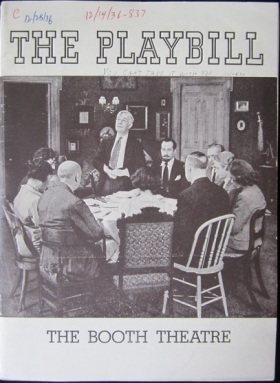
Happy New Year! Hope everyone had a great December, too. My vacation was fun. 🙂 Lots of movies. Lots of Sims. Lots of reading. Lots of trying to resurrect my long-dormant piano skills. And yes, if you saw my social media, we went to see The Last Jedi. Bliss.
Okay, let’s get down to business.
You Can’t Take It With You is an ironic choice for right after the holiday season (well, Epiphany is still coming up), but dang it, it sure is fun. Written by Moss Hart and George S. Kaufman, the play premiered on Broadway December 14, 1936 and ran for an impressive 838 performances. Even more impressive, the play garnered a Pulitzer for Drama.
Hollywood, of course, wasted no time vying to buy the rights to this prize, but Columbia finally won out, releasing a feature film in 1938 starring James Stewart, Jean Arthur, Lionel Barrymore, Edward Arnold, Ann Miller, Eddie “Rochester” Anderson, Spring Byington, and Donald Meek. Directed by Frank Capra, the film is an absolute delight. It went on to win Oscars for Best Picture and Best Director, as well as being nominated in six other categories.

While he left the basic outline of the story intact, Frank Capra made quite a few changes to You Can’t Take It With You. Some of the dialogue had to be left out because it wasn’t exactly Production Code-friendly, and as seems to be the usual thing with adapting plays for the screen, the action was taken outside. In the play, the Sycamore living room is almost another character, and it’s presented right off the bat, but the film eases the viewer in more gradually. It starts by showing big-time wheeler and dealer Anthony Kirby (Edward Arnold) thundering about why he can’t get the construction of his munitions factory off the ground. One of his yes men mentions timidly that a stubborn old guy who won’t sell his house is holding up the project.
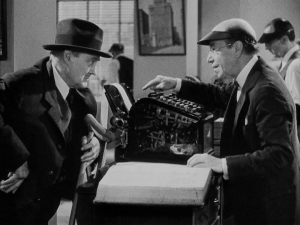 Speaking of the devil, the old guy in question, Martin Vanderhof (Lionel Barrymore) shows up to talk to Mr. Blakely, who, presumably, wants to lean on him some more about selling his house. He comes upon a jumpy little man, Mr. Poppins (Donald Meek) at an adding machine, totalling up figures. When pressed a little bit, though, Poppins confesses that what he really likes is building things, and shyly shows Vanderhof a windup toy he designed: a cute little bunny that pops out of a cabbage.
Speaking of the devil, the old guy in question, Martin Vanderhof (Lionel Barrymore) shows up to talk to Mr. Blakely, who, presumably, wants to lean on him some more about selling his house. He comes upon a jumpy little man, Mr. Poppins (Donald Meek) at an adding machine, totalling up figures. When pressed a little bit, though, Poppins confesses that what he really likes is building things, and shyly shows Vanderhof a windup toy he designed: a cute little bunny that pops out of a cabbage.

Vanderhof invites him to come over to his house, where he lives with his daughter and her family, the Sycamores. “Everyone does what they like.” Poppins wonders who takes care of them, and Vanderhof answers, “The same One who takes care of the lillies of the field, except we toil a little, spin a little. Have a barrel of fun.” Poppins balks at first, but a few sneers from his superior, the neurotically twitching Mr. Blakely (Clarence Wilson) and Poppins runs after Vanderhof. “The die is cast,” he flutters. “I’m a lily.”
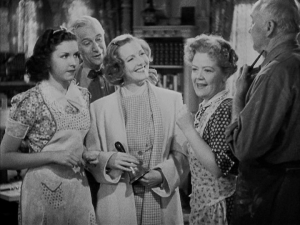 Vanderhof brings Poppins home, where everyone is involved in their usual whirl of daily activities. The Sycamores live in a Brooklyn brownstone, and as Vanderhof hinted, they’re not exactly a run-of-the-mill family. Penny Sycamore (Spring Byington) writes plays. Her husband, Paul, and his friend, Mr. De Pinna make fireworks in the basement. Paul and Penny’s daughter, Essie (Ann Miller), is an aspiring ballet dancer who’s longer on desire than talent. Her husband, Ed plays the xylophone and makes deliveries for Essie’s candy business. Vanderhof appraises stamps (in the play, he keeps snakes) and likes going to graduations. When the family sits down to meals, Vanderhof stands and prays, beginning with a “Well, Sir, here we are again…” Poppins is a little nervous at first, but then he quickly thrives.
Vanderhof brings Poppins home, where everyone is involved in their usual whirl of daily activities. The Sycamores live in a Brooklyn brownstone, and as Vanderhof hinted, they’re not exactly a run-of-the-mill family. Penny Sycamore (Spring Byington) writes plays. Her husband, Paul, and his friend, Mr. De Pinna make fireworks in the basement. Paul and Penny’s daughter, Essie (Ann Miller), is an aspiring ballet dancer who’s longer on desire than talent. Her husband, Ed plays the xylophone and makes deliveries for Essie’s candy business. Vanderhof appraises stamps (in the play, he keeps snakes) and likes going to graduations. When the family sits down to meals, Vanderhof stands and prays, beginning with a “Well, Sir, here we are again…” Poppins is a little nervous at first, but then he quickly thrives.
 Paul and Penny have a second daughter, Alice, and she’s the most serious of all the Sycamores, although she does enjoy sliding down the bannister. Alice is the closest of her family to Vanderhof, who’s known at home as Grandpa, maybe because she reminds him so much of his late wife. She’s also a very driven lady, and works as a stenographer for Tony Kirby (James Stewart), the son of the infamous Anthony P. Small world, isn’t it? Alice and Tony are in love, much to the chagrin of Tony’s uppercrust parents, his mother (Mary Forbes) in particular. That doesn’t deter Tony, a down-to-earth fellow who enjoyed experimenting with solar power until Anthony P. started grooming him to take over the family empire. Tony asks Alice to marry him, which she readily accepts.
Paul and Penny have a second daughter, Alice, and she’s the most serious of all the Sycamores, although she does enjoy sliding down the bannister. Alice is the closest of her family to Vanderhof, who’s known at home as Grandpa, maybe because she reminds him so much of his late wife. She’s also a very driven lady, and works as a stenographer for Tony Kirby (James Stewart), the son of the infamous Anthony P. Small world, isn’t it? Alice and Tony are in love, much to the chagrin of Tony’s uppercrust parents, his mother (Mary Forbes) in particular. That doesn’t deter Tony, a down-to-earth fellow who enjoyed experimenting with solar power until Anthony P. started grooming him to take over the family empire. Tony asks Alice to marry him, which she readily accepts.
 The worlds of the Sycamores and Kirbys collide when Alice and Tony make plans for the two families to meet. Alice tries to get her family to put on a little convention for the occasion, and that means cocktails and canapes. Tony wants his parents to meet the Sycamores as they are, so he accidentally-on-purpose brings his parents over on the wrong night.
The worlds of the Sycamores and Kirbys collide when Alice and Tony make plans for the two families to meet. Alice tries to get her family to put on a little convention for the occasion, and that means cocktails and canapes. Tony wants his parents to meet the Sycamores as they are, so he accidentally-on-purpose brings his parents over on the wrong night.
The Kirbys show up at the brownstone to find Penny painting Mr. De Pinna as a discus thrower, Essie having a ballet lesson, Mr. Poppins modeling Halloween masks, and a supper of hot dogs all set to go. The crowning moment happens when Alice slides down the bannister, only to find her future mother-in-law eyeing her scornfully. Oops. That’s awkward. The Sycamores gamely try to accomodate the Kirbys, but everyone’s uncomfortable, Anthony P. in particular–Penny gives him a rocking chair to sit in that hits him in the back of the head every time he sits down.
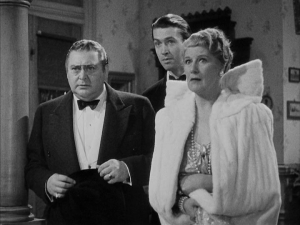 This visit starts a chain of events that lays everyone’s lives bare. In both the play and the film, the characters spend the night in jail, except that in the film we get to go with them. Anthony P. is literally a captive audience while Vanderhof tells him exactly what’s wrong with the relentless pursuit of money. It’s not so much about making deals and acquiring lots of stuff, because those things don’t transfer into the afterlife. Grandpa said what you can take with you is the love of your friends. In the play, Anthony P. comes looking for his son, who is at the Sycamore house trying to convince Alice not to bail on him. Either way, everyone ends up with smiles on their faces and their priorities straight. That’s not exactly a spoiler, because a story like this can’t help but end on a good note.
This visit starts a chain of events that lays everyone’s lives bare. In both the play and the film, the characters spend the night in jail, except that in the film we get to go with them. Anthony P. is literally a captive audience while Vanderhof tells him exactly what’s wrong with the relentless pursuit of money. It’s not so much about making deals and acquiring lots of stuff, because those things don’t transfer into the afterlife. Grandpa said what you can take with you is the love of your friends. In the play, Anthony P. comes looking for his son, who is at the Sycamore house trying to convince Alice not to bail on him. Either way, everyone ends up with smiles on their faces and their priorities straight. That’s not exactly a spoiler, because a story like this can’t help but end on a good note.
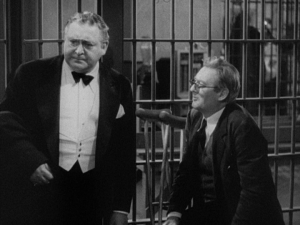 Capra’s son, Frank Capra Jr. said in an interview that his father made a point of drawing out the themes presented in the play. He wasn’t kidding–Capra’s interpretation is slightly less subtle than the Vegas Strip. When things go bad, they really go bad. When they go well, it’s wonderfully euphoric. In the film, Grandpa tells Anthony P. flat out that “you can’t take it with you,” but in the play, Grandpa says, “How many of us would be willing to settle when we’re young for what we eventually get? All those plans we make…what happens to them? It’s only a handful of the lucky ones that can look back and say they even came close.”
Capra’s son, Frank Capra Jr. said in an interview that his father made a point of drawing out the themes presented in the play. He wasn’t kidding–Capra’s interpretation is slightly less subtle than the Vegas Strip. When things go bad, they really go bad. When they go well, it’s wonderfully euphoric. In the film, Grandpa tells Anthony P. flat out that “you can’t take it with you,” but in the play, Grandpa says, “How many of us would be willing to settle when we’re young for what we eventually get? All those plans we make…what happens to them? It’s only a handful of the lucky ones that can look back and say they even came close.”
 The performances in the film are top-notch–there are a lot of very, very strong actors in the cast, and they were clearly happy with their roles. It’s always a treat when actors get material they like, because it shows in their faces, and there are so many layers to discover in the story. The dialogue just zings, too, and while the play and the film have their differences, they each bring it in their own way (Here’s a pdf copy of the play if anyone would like to do their own comparing and contrasting.). For Depression-era audiences, many of whom had spent roughly a decade doing without and making do, the messages of You Can’t Take It With You must have been very timely and encouraging. Seeing as a lot has stayed the same since the nineteen-thirties, its lessons still hold up.
The performances in the film are top-notch–there are a lot of very, very strong actors in the cast, and they were clearly happy with their roles. It’s always a treat when actors get material they like, because it shows in their faces, and there are so many layers to discover in the story. The dialogue just zings, too, and while the play and the film have their differences, they each bring it in their own way (Here’s a pdf copy of the play if anyone would like to do their own comparing and contrasting.). For Depression-era audiences, many of whom had spent roughly a decade doing without and making do, the messages of You Can’t Take It With You must have been very timely and encouraging. Seeing as a lot has stayed the same since the nineteen-thirties, its lessons still hold up.
Anyone a Robin Williams fan? Gill at Realweegiemidget and Crystal at In the Good Old Days of Classic Hollywood have the blogathon for you:

Just like Robin, it’ll be fun, crazy and unexpected. Thanks for reading, and see you next time!
This film is available on DVD from Amazon.
Bibliography
Kaufman, George S., and Hart, Moss. You Can’t Take It With You. New York: Dramatists Play Service, 1937. Renewed 1964.

Happy New Year to you, Rebecca. Great review. This is such a fun film. The whole cast are terrific, and I like how each person gets their chance to shine.
LikeLiked by 1 person
Thanks, Maddy–same to you! And I agree. I honestly don’t know which character is my favorite in this movie, because it all works so well. 🙂
LikeLike
Hi Gill! Oh, no–you didn’t miss it. I just haven’t formally announced it yet. I was making banners and was trying one of them out to make sure it was readable, but I forgot to take it down. I can DM you more particulars if you want, though. 🙂
LikeLiked by 1 person
Thanks, I will definitely give you more details! And yeah, I think I’ll have to remove these comments, because spoilers, lol. 🙂
LikeLiked by 1 person
Definitely
LikeLiked by 1 person
This is so entertaining to read–it makes me want to see the film. Thanks for the review.
LikeLiked by 1 person
You’re welcome, and I’m glad! It’s a fun movie–hope you like it. 🙂
LikeLiked by 1 person
Terrific cast in this film, and they work well together. What a treat it must have been, though, to see the original stage production. I might have to start a letter-writing campaign to see if one of our local theatre groups would produce this.
LikeLiked by 1 person
I agree–I’d love to see it onstage, too! There’s something about going to a play that’s so magical. 🙂
LikeLiked by 1 person